ภาพรวม
- เมื่อไตล้มเหลว การฟอกไตจะมีความจำเป็นเพื่อทดแทนการทำงานของไตในการกำจัดของเสียและน้ำส่วนเกิน
- การฟอกเลือด (Hemodialysis): กระบวนการนี้เกี่ยวข้องกับการกรองเลือดของผู้ป่วยภายนอกร่างกายผ่านเยื่อเทียมในเครื่องฟอกไต และคืนเลือดที่สะอาดกลับสู่ร่างกาย
- การฟอกไตทางช่องท้อง (Peritoneal Dialysis): ใช้เยื่อบุช่องท้องของผู้ป่วยซึ่งเป็นเยื่อธรรมชาติในช่องท้อง เพื่อกรองของเสียโดยการใส่ของเหลวสำหรับฟอกไตเข้าไปในช่องท้อง
- ความสำคัญของการบำบัดน้ำ: การบำบัดน้ำมีความสำคัญอย่างยิ่งต่อความปลอดภัยของของเหลวสำหรับการฟอกไต สารเคมีทั่วไปในน้ำประปา เช่น อะลูมิเนียม คลอรามีน ฟลูออไรด์ ทองแดง สังกะสี และเอนโดท็อกซิน อาจเป็นอันตรายต่อผู้ป่วยไต
- นวัตกรรมจากเครื่องวัดการไหลแบบอัลตราโซนิก LORRIC: LORRIC ultrasonic flowmeter ช่วยผู้ผลิตอุปกรณ์บำบัดน้ำโดยการเพิ่มระบบอัตโนมัติสำหรับการเก็บข้อมูลและการส่งข้อมูล ทำให้กระบวนการบำบัดน้ำมีความปลอดภัยและมีประสิทธิภาพยิ่งขึ้น
1. สามารถหยุดฟอกไตได้หรือไม่? วิธีป้องกัน
การหยุดฟอกไต
การฟอกไตจะต้องดำเนินต่อไปหรือไม่ขึ้นอยู่กับความรุนแรงของโรคไต
●ในกรณีของไตวายเฉียบพลัน ผู้ป่วยอาจต้องการการฟอกไตในระยะสั้น ซึ่งสามารถหยุดได้หากการทำงานของไตฟื้นตัว
●สำหรับผู้ป่วยโรคไตเรื้อรัง การฟอกไตมักจำเป็นในระยะยาวหรืออาจตลอดชีวิต เว้นแต่จะได้รับการปลูกถ่ายไต ซึ่งต้องอาศัยผู้บริจาคที่เหมาะสมและผู้ป่วยต้องผ่านเกณฑ์เฉพาะสำหรับการผ่าตัด
การป้องกันโรคไต
ผู้ป่วยจำนวนมากได้รับการวินิจฉัยว่าเป็นโรคเรื้อรัง เช่น ความดันโลหิตสูง น้ำตาลในเลือดสูง และคอเลสเตอรอลสูง ซึ่งอาจนำไปสู่โรคไตเรื้อรังก่อนเริ่มการฟอกไตเป็นเวลาหลายปี เพื่อป้องกันโรคไตควรมุ่งเน้นที่:
●การควบคุมโรคประจำตัว
●การรักษาน้ำหนักตัวให้อยู่ในเกณฑ์ปกติ
●การออกกำลังกายอย่างสม่ำเสมอ
●การตรวจสุขภาพประจำปี เช่น การตรวจเลือด (ตรวจครีเอตินีนและบียูเอ็น) และการตรวจปัสสาวะ (หาปริมาณโปรตีน)
การเฝ้าระวังอาการ
ควรสังเกตอาการผิดปกติ เช่น ขาบวม ปัสสาวะเป็นฟอง หรือมีเลือดในปัสสาวะ เพื่อรับการรักษาและป้องกันก่อนอาการจะรุนแรงขึ้น
2. การฟอกไตทำงานอย่างไร? การฟอกเลือดคืออะไร
การฟอกไต หรือที่เรียกกันทั่วไปว่า "การฟอกไตทางไต" ประกอบด้วยสองประเภทหลัก ได้แก่ การฟอกเลือด (Hemodialysis) และ การฟอกไตทางช่องท้อง (Peritoneal Dialysis)
● การฟอกเลือด: ใช้ระบบวงจรภายนอกร่างกายเพื่อล้างเลือด โดยเลือดจะถูกกรองผ่านเยื่อเทียมในเครื่องฟอกไต และส่งกลับเข้าสู่ร่างกาย
● การฟอกไตทางช่องท้อง: ใช้เยื่อบุช่องท้อง (Peritoneum) ของร่างกายเป็นตัวกรอง โดยใส่ของเหลวสำหรับฟอกไตเข้าไปในช่องท้อง
ในไต้หวัน ผู้ป่วยส่วนใหญ่นิยมเลือกใช้การฟอกเลือด เนื่องจากสะดวกและมีประสิทธิภาพในการล้างของเสียออกจากร่างกาย
1) การฟอกเลือด (Hemodialysis)
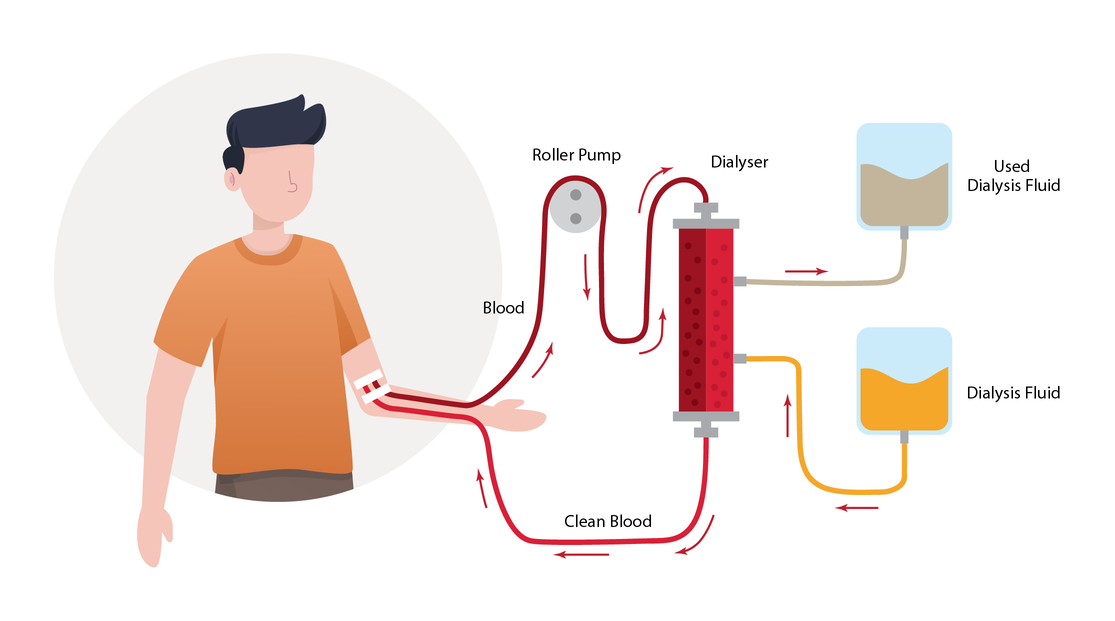
การฟอกเลือดคือกระบวนการที่ดึงเลือดของผู้ป่วยออกจากร่างกาย นำไปกรอง และคืนกลับเข้าสู่ร่างกาย เลือดจะถูกส่งผ่านเครื่องฟอกไต ซึ่งเรียกอีกชื่อหนึ่งว่า "ไตเทียม" โดยผ่านเยื่อกรองกึ่งซึมผ่านได้ (Semipermeable Membrane) เพื่อลบของเสียและน้ำส่วนเกินออกจากเลือด
การรักษานี้มักต้องไปที่ศูนย์ฟอกไต โดยทั่วไป 2-3 ครั้งต่อสัปดาห์ แต่ละครั้งใช้เวลาประมาณ 4-5 ชั่วโมง เนื่องจากการฟอกเลือดกำจัดของเสียและน้ำในร่างกายเป็นระยะ ๆ ผู้ป่วยจึงจำเป็นต้องปฏิบัติตามอาหารอย่างเคร่งครัด โดย:
● จำกัดการบริโภคโพแทสเซียม ฟอสฟอรัส เกลือ และน้ำ
● รับโปรตีนในปริมาณที่เหมาะสม (ประมาณ 1.0-1.2 กรัม/กก.)
● สำหรับผู้ป่วยเบาหวาน อาจต้องจำกัดการบริโภคน้ำตาลด้วย
[1]
2) การฟอกไตทางช่องท้อง (Peritoneal Dialysis)
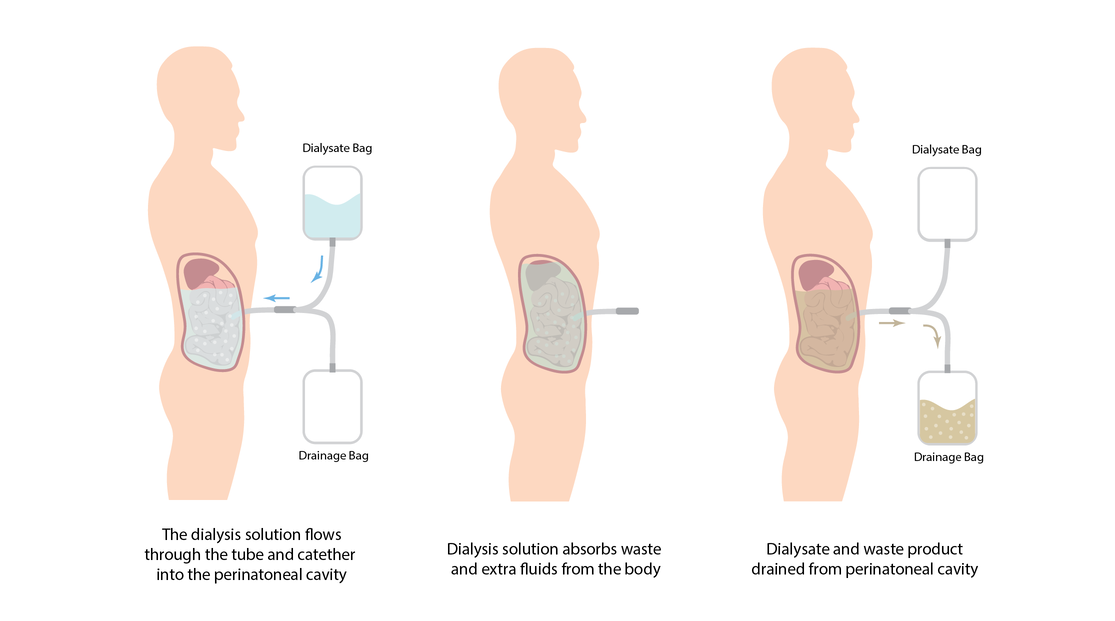
การฟอกไตทางช่องท้อง (PD) ใช้เยื่อบุช่องท้องตามธรรมชาติของผู้ป่วย ซึ่งเป็นเยื่อกรองกึ่งซึมผ่านได้ในการกรองเลือดภายในร่างกาย โดยศัลยแพทย์จะใส่สายสวน (Catheter) เข้าไปในช่องท้องเพื่อใช้เป็นช่องทางสำหรับของเหลวสำหรับฟอกไต ผู้ป่วยสามารถใช้เครื่อง Continuous Ambulatory Peritoneal Dialysis (CAPD) ที่บ้านเพื่อทำการรักษา
ในกระบวนการรักษา ของเหลวสำหรับฟอกไตจะถูกใส่เข้าไปในช่องท้องผ่านสายสวน ของเหลวจะแลกเปลี่ยนของเสียและอิเล็กโทรไลต์กับเลือดผ่านเยื่อบุช่องท้อง จากนั้นของเหลวจะถูกระบายออก
รูปแบบการรักษา:
การฟอกไตทางช่องท้องสามารถทำได้ที่บ้าน โดยผู้ป่วยจะเปลี่ยนของเหลวสำหรับฟอกไตวันละ 4-5 ครั้ง แต่ละครั้งใช้เวลาประมาณ 4 ชั่วโมง
- อีกทางเลือกหนึ่งคือ Automated Peritoneal Dialysis (APD) ซึ่งทำงานโดยอัตโนมัติในช่วงเวลากลางคืนขณะที่ผู้ป่วยนอนหลับ
ข้อดีและข้อควรระวัง:
ข้อจำกัดด้านอาหารมีความเข้มงวดน้อยกว่าการฟอกเลือด แต่ผู้ป่วยต้องปฏิบัติขั้นตอนอย่างระมัดระวัง และดูแลสายสวนเพื่อป้องกันการเคลื่อนที่หรือการติดเชื้อ
[2]
3) การบำบัดน้ำในอุปกรณ์ฟอกไต
ในการฟอกเลือด น้ำยาสำหรับฟอกไตมีปฏิสัมพันธ์โดยตรงกับเลือดของผู้ป่วย ทำให้คุณภาพน้ำมีความสำคัญอย่างยิ่ง โรงพยาบาลจึงต้องบังคับใช้มาตรฐานคุณภาพน้ำที่เข้มงวดเพื่อความปลอดภัยของผู้ป่วย
สารเคมีทั่วไปในน้ำประปา เช่น อะลูมิเนียม คลอรามีน ฟลูออไรด์ ทองแดง และสังกะสี อาจเป็นอันตรายต่อผู้ป่วยโรคไต หากไม่ได้รับการกรองอย่างเหมาะสม การทำความเข้าใจถึงความเสี่ยงเหล่านี้ช่วยเน้นย้ำถึงความสำคัญของการบำบัดน้ำในอุปกรณ์ฟอกไต เพื่อให้มั่นใจว่าน้ำที่ใช้ปราศจากสารปนเปื้อนที่เป็นอันตรายและปลอดภัยต่อการใช้งานทางการแพทย์
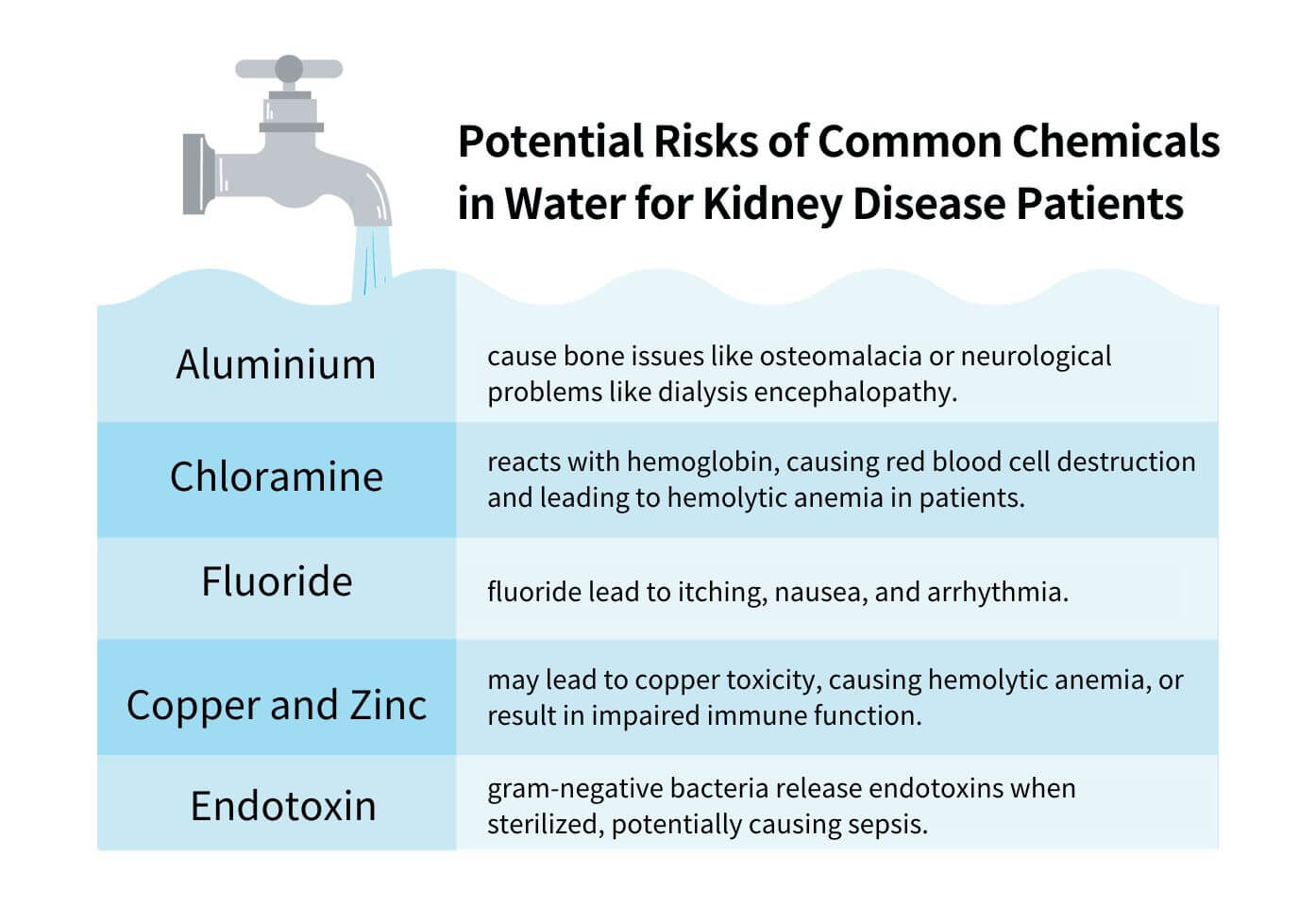
อลูมิเนียม
ระบบน้ำประปามักมีอลูมิเนียมซึ่งใช้เป็นสารจับตะกอนเพื่อกำจัดอนุภาคที่แขวนลอยในน้ำ ในผู้ที่มีไตแข็งแรง ไตสามารถกรองอลูมิเนียมส่วนเกินได้ แต่ในผู้ที่มีไตเสื่อมสมรรถภาพ อลูมิเนียมอาจสะสมในร่างกาย ทำให้เกิดโรคกระดูกอ่อน (osteomalacia) และโรคสมองจากการฟอกไต (dialysis encephalopathy) ซึ่งเป็นความผิดปกติทางระบบประสาท
คลอรามีน
คลอรามีนเป็นสารฆ่าเชื้อที่ใช้ในน้ำดื่ม มีประสิทธิภาพในระบบการจ่ายน้ำที่ยาวนาน อย่างไรก็ตาม หากคลอรามีนไม่ถูกกำจัดในระหว่างการฟอกไต อาจผ่านเยื่อกรองฟอกไตเข้าสู่กระแสเลือด และทำปฏิกิริยากับฮีโมโกลบิน ทำให้เกิดโรคโลหิตจางจากการแตกตัวของเม็ดเลือดแดง (hemolytic anemia)
ฟลูออไรด์
ฟลูออไรด์ ซึ่งเป็นที่รู้จักในด้านการเสริมความแข็งแรงของเคลือบฟัน ถูกเติมลงในน้ำดื่มเพื่อส่งเสริมสุขภาพช่องปาก อย่างไรก็ตาม สำหรับผู้ป่วยไต ฟลูออไรด์ส่วนเกินไม่สามารถกรองออกได้อย่างมีประสิทธิภาพ อาจทำให้เกิดอาการคัน คลื่นไส้ และภาวะหัวใจเต้นผิดจังหวะ (arrhythmia)
ทองแดงและสังกะสี
ทองแดงและสังกะสีอาจหลุดออกมาจากท่อประปาและอุปกรณ์เข้ามาในระบบน้ำ ในผู้ที่มีไตแข็งแรง ไตสามารถควบคุมระดับโลหะเหล่านี้ได้ แต่ในผู้ที่มีไตเสื่อมสมรรถภาพ อาจเกิดพิษจากทองแดง โรคโลหิตจางจากการแตกตัวของเม็ดเลือดแดง หรือการทำงานของระบบภูมิคุ้มกันบกพร่อง
เอนโดทอกซิน
น้ำประปาอาจมีจุลินทรีย์รวมถึงแบคทีเรียแกรมลบ แม้ว่าคลอรามีนในระบบน้ำของเทศบาลจะฆ่าเชื้อแบคทีเรีย แต่ผนังเซลล์ที่ตายแล้วของแบคทีเรียเหล่านี้สามารถปล่อยเอนโดทอกซินออกมาได้ โดยปกติเอนโดทอกซินจะถูกกำจัดโดยตับและระบบภูมิคุ้มกัน แต่หากไม่ถูกกรองออกในระหว่างการฟอกไต อาจทำให้เกิดภาวะพิษในกระแสเลือด (sepsis)
4. น้ำบริสุทธิ์พิเศษ (Ultrapure Water) คืออะไร และผลิตขึ้นอย่างไร?
การทำความเข้าใจถึงความเสี่ยงที่สารทั่วไปในน้ำประปาสามารถก่อให้เกิดกับผู้ป่วยโรคไตเน้นย้ำถึงความสำคัญของการบำบัดน้ำในกระบวนการฟอกเลือด เพื่อบรรเทาความเสี่ยงเหล่านี้ ศูนย์ฟอกไตจึงผลิต "น้ำยาสำหรับฟอกไตที่บริสุทธิ์พิเศษ (Ultrapure Dialysis Fluid)" ตามมาตรฐานความบริสุทธิ์น้ำที่เข้มงวด ซึ่งกำหนดโดย Association for the Advancement of Medical Instrumentation (AAMI) และ International Organization for Standardization (ISO)
มาตรฐานความบริสุทธิ์:
จำนวนจุลินทรีย์ในน้ำ ต้องน้อยกว่า 100 CFU/mL
ระดับเอนโดท็อกซิน ต้องต่ำกว่า 0.25 EU/mL
น้ำบริสุทธิ์พิเศษนี้มีความสำคัญอย่างยิ่งในการทำความสะอาดเลือดของผู้ป่วยระหว่างการฟอกไต โดยช่วยลดความเสี่ยงในการนำสารปนเปื้อนที่เป็นอันตรายเข้าสู่ร่างกาย
[3]
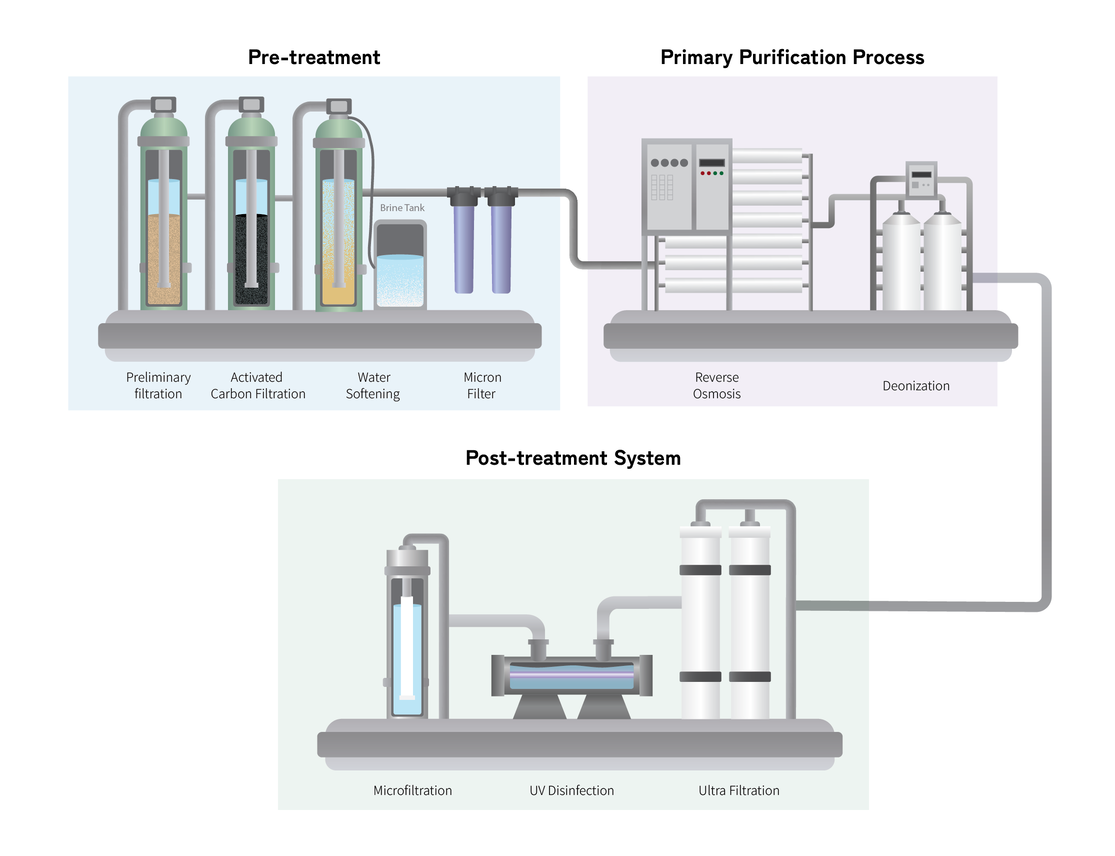
1) การบำบัดเบื้องต้น (Pre-treatment)
เป้าหมายหลักของการบำบัดเบื้องต้นคือการกรองสิ่งปนเปื้อนและปกป้องระบบบำบัดหลัก
1. การกรองเบื้องต้น (Preliminary Filtration): กำจัดอนุภาคขนาดใหญ่ ตะกอน และของแข็งแขวนลอย
2. การกรองด้วยถ่านกัมมันต์ (Activated Carbon Filtration): น้ำไหลผ่านตัวกรองที่มีถ่านกัมมันต์เม็ด (Granular Activated Carbon - GAC) เพื่อดูดซับสารปนเปื้อนอินทรีย์ คลอรีนตกค้าง และคลอรามีน
3. การทำให้น้ำอ่อน (Water Softening): ใช้เรซินแลกเปลี่ยนไอออนเพื่อเปลี่ยนไอออนแคลเซียมและแมกนีเซียมเป็นไอออนโซเดียม เพื่อป้องกันการเกิดตะกรัน
4. ตัวกรองไมครอน (Micron Filters): กรองสิ่งปนเปื้อนที่มีขนาดเล็กถึง 1 ไมครอน
2) กระบวนการบำบัดหลัก (Primary Purification Process)
ขั้นตอนนี้มุ่งเน้นการบำบัดน้ำให้มีความบริสุทธิ์ในระดับสูง
5. การรีเวิร์สออสโมซิส (Reverse Osmosis, RO): ใช้แรงดันออสโมติกให้น้ำไหลผ่านเยื่อกรองกึ่งซึมผ่านได้ เพื่อลบสิ่งปนเปื้อนกว่า 90% เช่น เกลือละลาย ไอออนโลหะ แบคทีเรีย และเอนโดท็อกซิน
6. การกำจัดไอออน (Deionization, DI): ใช้เรซินแลกเปลี่ยนไอออนแบบผสม (Mixed-Bed Ion Exchange Resins) เพื่อลบไอออนประจุบวกและลบที่เหลืออยู่ กำจัดสารปนเปื้อนในรูปแบบไอออนได้อย่างสมบูรณ์
3) ระบบบำบัดขั้นสุดท้าย (Post-treatment System)
ขั้นตอนนี้เน้นการฆ่าเชื้อและการกรองเพื่อให้น้ำมีความบริสุทธิ์สูงสุด
7. การกรองระดับนาโน (Ultrafiltration, UF): กำจัดแบคทีเรียที่อาจเติบโตในกระบวนการ DI เนื่องจากสภาพแวดล้อมที่มีความชื้น
8. การฆ่าเชื้อด้วยรังสีอัลตราไวโอเลต (Ultraviolet Disinfection, UV): ใช้แสง UV-C เพื่อทำลาย DNA และ RNA ของจุลินทรีย์ ทำให้น้ำปลอดเชื้อได้อย่างมีประสิทธิภาพ
9. การกรองระดับไมโคร (Microfiltration): ขั้นตอนสุดท้ายใช้ตัวกรองขนาด 0.2 ไมครอน เพื่อให้น้ำมีความบริสุทธิ์สูงสุด เหมาะสำหรับการใช้งานในกระบวนการฟอกไต
[4][5][6]
5. เครื่องวัดการไหลแบบอัลตราโซนิกและการเก็บข้อมูลอัตโนมัติ
ระหว่างการเยี่ยมชมบริษัท Lee Med Tech Co., Ltd. ในอำเภอน้ำพอง ประเทศไทย เราได้สำรวจว่าเครื่องวัดการไหลแบบอัลตราโซนิกและเซ็นเซอร์อื่น ๆ ช่วยในการเก็บรวบรวมและส่งข้อมูลอัตโนมัติในระบบบำบัดน้ำได้อย่างไร บริษัท Lee Med Tech Co., Ltd. ให้บริการอุปกรณ์บำบัดน้ำและบริการข้อมูลบนคลาวด์สำหรับศูนย์ฟอกไตของโรงพยาบาลค่ายกาวิละ
ข้อมูลที่เก็บรวบรวมจะถูกส่งไปยังแพลตฟอร์มคลาวด์เพื่อการวิเคราะห์และบำรุงรักษาแบบเรียลไทม์ ช่วยเพิ่มความน่าเชื่อถือและความปลอดภัยของกระบวนการบำบัดน้ำ หากต้องการรายละเอียดเพิ่มเติมเกี่ยวกับบทบาทของเซ็นเซอร์ในเทคโนโลยีทางการแพทย์และระบบน้ำบริสุทธิ์พิเศษ โปรดอ่านบทความ "Sensors in Medical Technology and Ultra-Pure Water Systems."
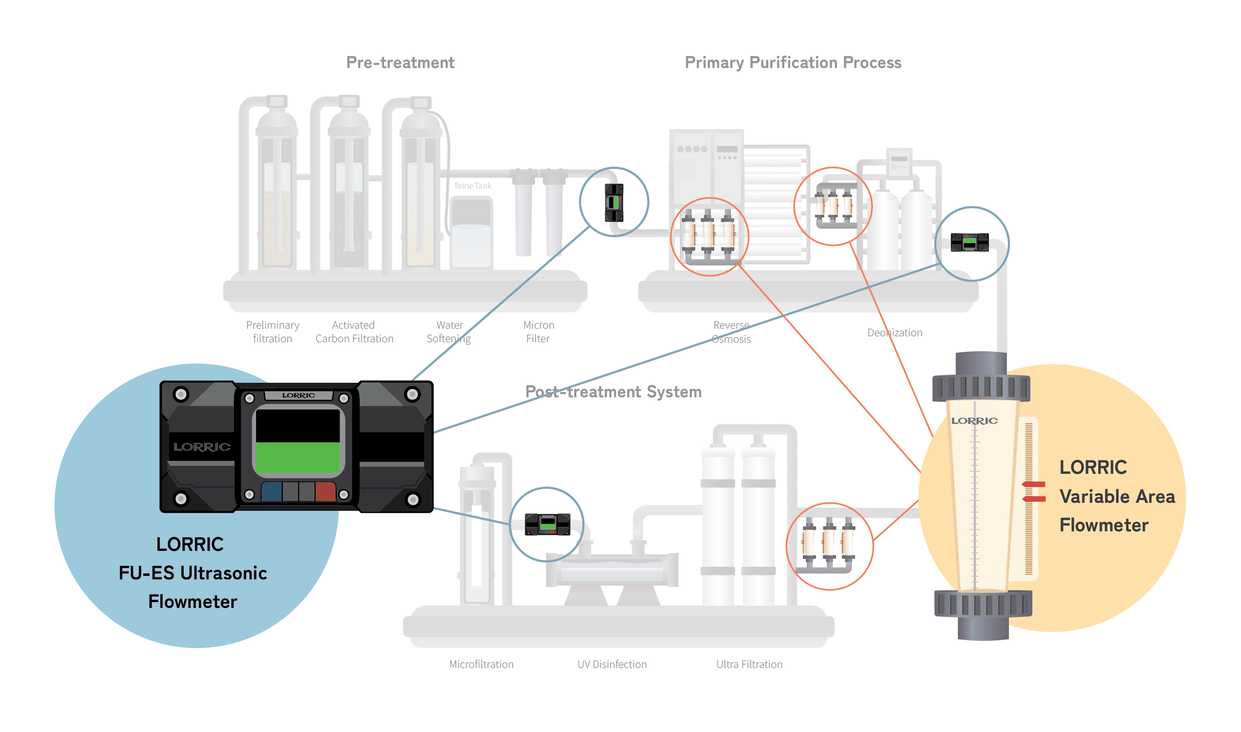
เราได้ติดตั้ง เครื่องวัดการไหลแบบอัลตราโซนิก LORRIC FU-ES บนท่อของอุปกรณ์รีเวิร์สออสโมซิส (RO) ในสถานที่ เครื่องวัดการไหลเหล่านี้รองรับ โปรโตคอลการสื่อสาร RS485 ช่วยให้สามารถส่งข้อมูลการไหลที่ตรวจจับได้ไปยัง **ตัวควบคุมแบบโปรแกรมได้ (PLC)
● รายละเอียดการทำงาน:
- PLC ประมวลผลสัญญาณอินพุตตามคำสั่งควบคุมที่ตั้งโปรแกรมไว้ เพื่อควบคุมและทำให้ระบบกลไกและไฟฟ้าทำงานโดยอัตโนมัติ
- ข้อมูลที่รวบรวมโดย PLC ถูกส่งผ่านโปรโตคอล MQTT โดยใช้ TCP/IP ไปยังเครือข่ายคลาวด์ที่กำหนด
● ข้อดีของระบบนี้สำหรับโรงพยาบาล:
- สามารถรวบรวมและจัดระเบียบข้อมูลการใช้น้ำสำหรับการฟอกไตได้อย่างมีประสิทธิภาพ
- เจ้าหน้าที่สามารถเข้าสู่ฐานข้อมูลคลาวด์เพื่อเข้าถึงข้อมูลการบริโภคน้ำและข้อมูลที่เกี่ยวข้องแบบเรียลไทม์ได้จากคอมพิวเตอร์หรืออุปกรณ์เคลื่อนที่
- ช่วยเพิ่มประสิทธิภาพในการตรวจสอบและการจัดการระบบน้ำ
ระบบนี้ช่วยเสริมความสะดวกและความแม่นยำในการบริหารจัดการน้ำสำหรับกระบวนการฟอกไตของโรงพยาบาลได้อย่างมีประสิทธิภาพสูงสุด
[7][8]
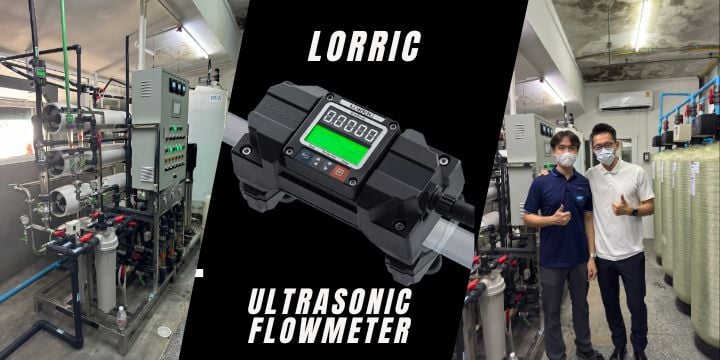
ทำไมต้องเลือก "LORRIC FU-ES Ultrasonic Flow Meter"?
ติดตั้งง่ายโดยไม่ต้องสัมผัสภายในท่อ: เครื่องวัดการไหลแบบอัลตราโซนิก FU-ES มาพร้อมการออกแบบแบบหนีบท่อ (clamp-on) ที่ช่วยให้ติดตั้งได้โดยไม่ต้องตัดท่อหรือหยุดระบบ ทำให้สามารถติดตั้งอุปกรณ์ได้โดยไม่รบกวนการทำงาน
รองรับโปรโตคอลการสื่อสารที่หลากหลาย: FU-ES รองรับโปรโตคอลการสื่อสารหลากหลาย เพื่อตอบสนองความต้องการที่เฉพาะเจาะจง รวมถึงเอาต์พุตอนาล็อก 16 บิต 4-20mA, Modbus RTU RS485 และสัญญาณสวิตช์ออปติคัลคัปเปลอร์แบบสองสาย (ใช้งานร่วมกับ NPN/PNP)
เทคโนโลยี EchoSense: ซอฟต์แวร์เทคโนโลยีขั้นสูงนี้สามารถตรวจจับข้อมูล เช่น เส้นผ่านศูนย์กลางของท่อ ข้อมูลจำเพาะของท่อ และสภาพแวดล้อมในการตรวจจับโดยอัตโนมัติ เครื่องสามารถใช้งานได้ทันทีหลังการติดตั้งโดยไม่ต้องตั้งค่าพารามิเตอร์ที่ซับซ้อน ระหว่างการเยี่ยมชมบริษัท Lee Med Tech เครื่อง FU-ES ถูกติดตั้งบนท่อ PVC สแตนเลส 316 และ PVDF ได้อย่างมีประสิทธิภาพ แสดงให้เห็นถึงความน่าเชื่อถือเมื่อใช้งานกับวัสดุที่หลากหลาย
ด้วยการรองรับการสื่อสารที่หลากหลายและการออกแบบที่ติดตั้งได้ง่ายของ FU-ES LORRIC ได้ช่วยให้ผู้ผลิตอุปกรณ์สามารถเก็บรวบรวมข้อมูลการไหลแบบอัตโนมัติ พร้อมทั้งมอบฐานข้อมูลบนคลาวด์ให้กับศูนย์ฟอกไต เราหวังว่าแบรนด์จะยังคงสนับสนุนการพัฒนาแอปพลิเคชันในอุตสาหกรรมอุปกรณ์และการแพทย์ต่อไป
เรียนรู้เพิ่มเติมเกี่ยวกับ :
LORRIC FU-ES Ultrasonic Flow Meter